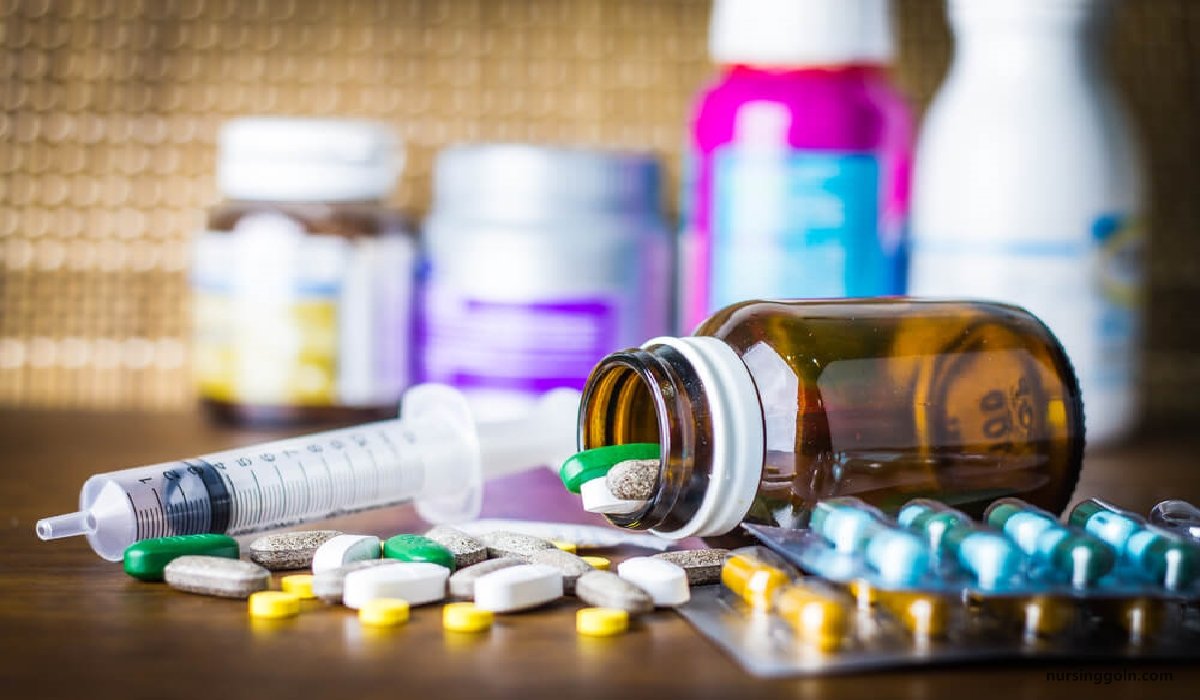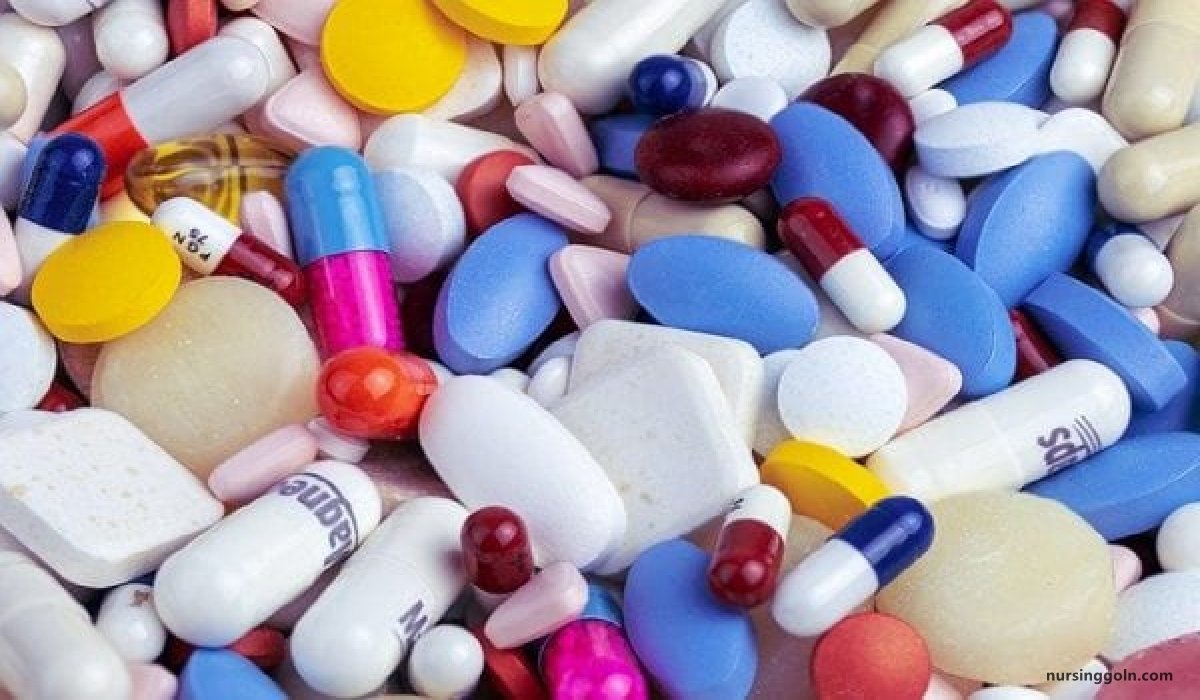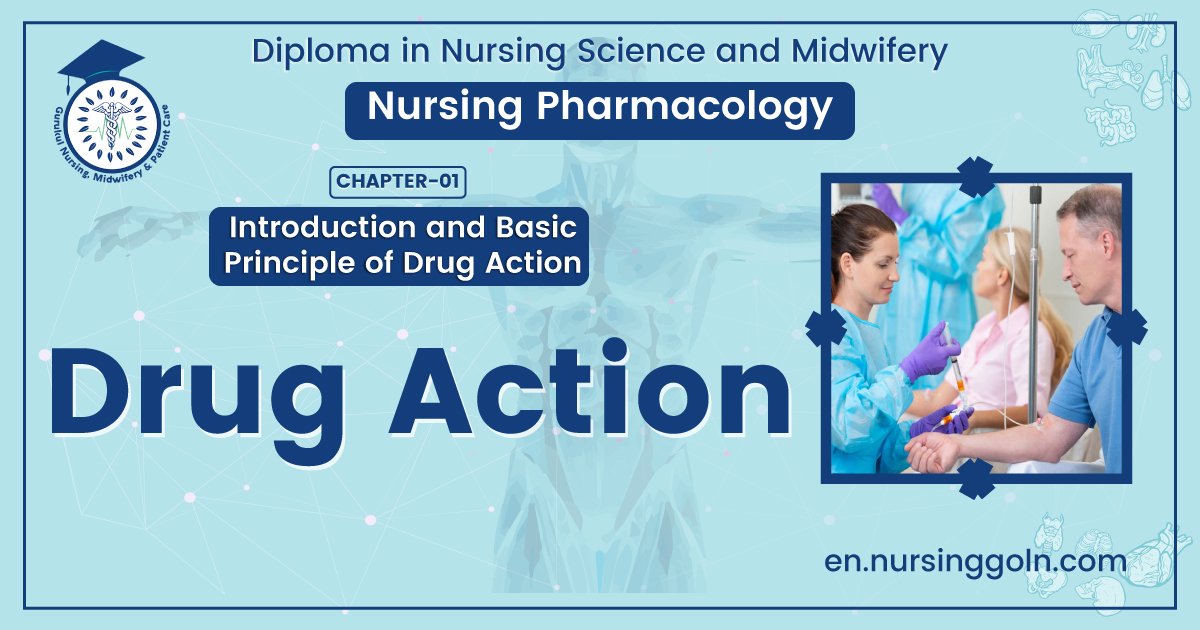Drug action – This book covers the entire syllabus of “Pharmacology” prescribed by BNMC- for diploma in nursing science & midwifery students. We tried to accommodate the latest information and topics. This book is an examination setup according to the teachers’ lectures and examination questions.
At the end of the book, previous questions are given. We hope in touch with the book students’ knowledge will be upgraded and flourish. The unique way of presentation may make your reading of the book a pleasurable experience.

Drug action
Definition of Drug Action:
The action of drugs on the human body is called pharmacodynamics, and what the body does with the drug is called pharmacokinetics. The drugs that enter the human tend to stimulate certain receptors, ion channels, act on enzymes or transporter proteins. As a result, they cause the human body to react in a specific way.
(Ref by-https://en.wikipedia.org)
Principles of Drug Action
Drugs (except those gene based) do not impart new functions to any system, organ or cell; they only alter the pace of ongoing activity. However, this alone can have profound medicinal as well as toxicological impact. The basic types of drug action can be broadly classed as:
1. Stimulation: Some drugs act by increasing the activity of specialised cells, e.g. adrenaline stimulates the heart resulting in an increase in heart rate and force of contraction.
2. Depression: Some drugs act by decreasing the activity of specialized cells, e.g. alcohol, barbiturates, general anaesthetics, etc. depress the central nervous system.
3. Irritation: Certain agents on topical application can cause irritation of the skin and adjacent tissues. When an agent on application to the skin relieves deep seated pain, it is known as counterirritant, e.g. eucallptus oil, methyl salirylate, etc. They are useful in sprains, joint pain and myalgia. They exert their action by:
- Reflexly increasing local circulation in deeper structures.
- Blocking impulse conduction in the spinal cord.
4. Replacement: When there is a deficiency of endogenous substances, they can be replaced by drugs, e.g. insulin in diabetes mellitus, thyroxine in cretinism and myxedema, etc.
5. Cytotoxic: Drugs are selectively toxic for the infecting organism/cancer cells, e.g. antibiotics/anticancer drugs.

Mechanism of Drug Action
Receptor mediated Non-receptor-mediated Mechanism of Action of Drugs:
1. By physical action:
a) Osmosis: Some drugs act by exerting an osmotic effect, e.g. 20%o mannitol in cerebral oedema and acute congestive glaucoma.
b) Absorption: Activated charcoal adsorbs toxins, hence it is used in the treatment of drug poisoning.
c) Demulcent: Cough syrup produces a soothing effect in pharyngitis by coating the inflamed mucosa.
d) Radio-activity: Radioactive isotopes emit rays and destroy the tissues, e.g. 1311 in hyperthyroidism.
2. By chemical action:
a) Antacids are weak bases they neutralise gastric acid – useful in peptic ulcer.
b) Metals like iron, copper, mercury etc. are eliminated from the body with the help of chelating agents. They trap metals and form water-soluble complexes, which are rapidly excreted from the body, e.g. dimercaprol (BAL) in arsenic poisoning, desferrioxamine in iron poisoning, d- penicillamine in copper poisoning.
3. Through enzymes: Some drugs act by inhibiting the enzyme activity.
a) Drug action via enzyme inhibition:
Angiotensin-converting enzyme (ACE) inhibitors, such as captopril, enalapril, etc. act by inhibiting ACE. Hence, they are used in the treatment of hypertension, CHF, etc.
Xanthine and hypoxanthine are oxidised to uric acid by the enzyme xanthine oxidase, which is inhibited by allopurinol. Allopurinol is used in the treatment of chronic gout to reduce the synthesis of uric acid.
4. Through ion channels: Some drugs directly bind to ion channels and alter the flow of ions, e.g. local anaesthetics block sodium channels in neuronal membrane to produce local anaesthesia.
5. Through antibody production: Vaccines produce their effect by stimulating the formation of antibodies, e.g. vaccine against tuberculosis (BCG), oral polio vaccine, etc.
6. Transporters: Some drugs produce their effect by binding to transporters. Selective serotonin reuptake inhibitors (SSRIs) + bind to 5-HT transporter + block 5-HT reuptake into neurons -) antidepressant effect.
7. Others: Anticancer drugs like cyclophosphamide produce their effect by binding to nucleic acids; drugs like colchicine bind to tubulin and prevent migration of neutrophils (hence useful in acute gout).
Receptor-mediated Mechanisms:
Drugs act as signals, and their receptors act as signal detectors. Receptors transduce their recognition of a bound agonist by initiating a series of reactions that ultimately result in a specific intracellular response.

Targets of Drug Action
- Drug receptors
- Enzymes
- Transmembrane target proteins
- Ion channels.
Factors Influencing Drug Action:
A. The dose: Very small dose of drug will not be effective while over dose may cause harmful effects. So the drug produces its beneficial effect only in proper therapeutic doses.
B. Age and body weight: Children and old persons are more sensitive to drugs and therefore, require smaller dose. The ratio of body weight to the amount of drug determines the level of concentration of the drug in body. An adult person having a very thin body or less body weight requires smaller dose than an overweight person.
C. The route of administering drug: Drug by mouth has less effect. In injection form whole of drug goes to blood.
D. The time of administration: Drug is more quickly absorbed almost, if given by mouth on empty stomach, whereas it is delayed, if given after full meal. Drugs which cause stomach
irritation are given with meal or after meal.
E. Presence of vomiting: When a drug is given to a diarrhea patient, due to rapid peristalsis drug is quickly expelled out from the site of absorption and gets less time for its absorption. So it causes less effect. Similarly a vomiting person may expel out the drug by mouth completely or partially resulting less or no effect.
F. Technique of administration: For optional effect of drug it should be given by proper route by proper technique in correct dose.
Read more:
